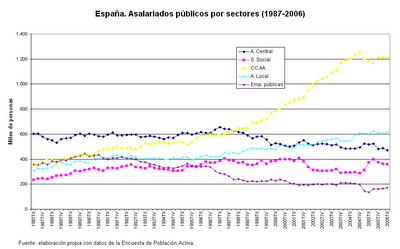Textos recientes sobre la libre elección escolar
The Economist (via joannejacobs.com) ensalzó la semana pasada las virtudes del sistema escolar de Alberta (Canadá), recogiendo la experiencia de la ciudad de Edmonton, en la que, al parecer, han montado un sistema público de libre elección, y funciona bien:
This is especially true in the province's capital of Edmonton, which is noted for its innovative system stressing choice, accountability and competition. Funding there is based on the number of students in a school. Each school controls its own budget, spending money on its own educational priorities (such as improving aboriginal-student results), while following the provincial curriculum. Students are free to (and 57% do) attend any school in the city, not just in their own neighbourhood. They can seek out schools specialising in the arts, sports, leadership skills, girls-only education, aboriginal culture, Mandarin, and many other alternative programmes—or simply choose the schools with the best academic results. Students in every grade are tested annually and their scores published.El Cato Institute acaba de publicar "Giving Kids the Chaff: How to Find and Keep the Teachers We Need" (pdf, gratis), un paper acerca de cómo reclutan su profesorado las escuelas en Estados Unidos, en el que se muestra que los administradores de las escuelas se toman más en serio ese reclutamiento si operan en un entorno con mayor competición entre las escuelas. Del resumen:
In districts where school choice fosters competition among schools, public school administrators seek out higher-performing applicants and work harder to retain them. That effect is especially pronounced in low-income districts and can meaningfully improve educational outcomes for poor students. School choice can help improve the quality of the teacher labor force, thereby boosting student achievement and restoring meritocracy to the education system.
Además, el Cato acaba de publicar Liberty & Learning: Milton Friedman's Voucher Idea at Fifty, un libro escrito por varios especialistas sobre el cheque escolar acerca de los avatares de esta idea y su potencial actual y futuro.
Una de las mayores especialistas estadounidenses en estudios sobre los efectos de la libre elección y la competición entre escuelas en el rendimiento escolar, Caroline Hoxby, acaba de publicar un paper titulado "School Choice: The Three Essential Elements and Several Policy Options" (pdf, 1,85 Mb; via Marginal Revolution). Esos tres elementos esenciales son los siguientes:
Supply flexibility, which means that schools should have the ability to open where there is demand for them, expand with increased demand and contract with reduced demand
Money should follow students, which means that funding policies must be designed so that schools that are in demand have the funds to expand and those that are not in demand lose funds and must contract; and
Independent management of schools, which means that schools must be free to innovate in a range of areas, including pedagogy, teacher pay, budget allocation, and the way the school is organised.
El problema es que no suelen darse juntas, ni de lejos. Es improbable que cada una, aisladamente, sirva para mucho. Por ejemplo, un sistema de cheque escolar en el que no haya una mínima capacidad de las escuelas para ajustar su oferta a la demanda o para incitar a ésta, es improbable que pueda ejercer efectos benéficos.
Por último, algo de "droga dura". Nada de parches como el cheque escolar. En su más puro estado, la crítica rothbardiana a la educación pública, republicada por el Mises Institute: Education: Free and Compulsory.




